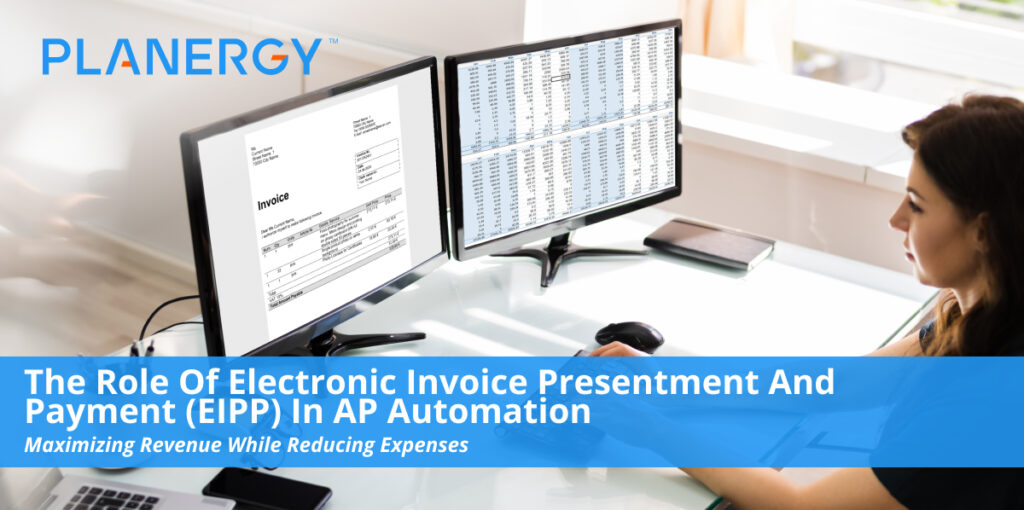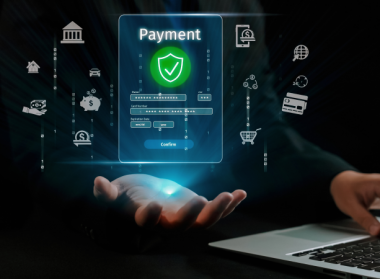Since it first began to see widespread adoption in the business community, digital transformation has been heralded as a revolutionary (and evolutionary) step in achieving new levels of efficiency, cost savings, profitability, and functionality.
Built as it is on iterative improvement, however, the potential for even greater performance is always present.
Consider the accounts payable function, where tools such as optical character recognition (OCR), real-time, centralized data management, and process automation have already changed the game for companies around the world.
But breaking through to even greater levels of AP performance requires the addition of more powerful and versatile tools.
Properly leveraged, one such tool—electronic invoice presentment and payment (EIPP)—can help AP teams streamline their payment processes and leave paper invoices behind for good.
What is Electronic Invoice Presentment and Payment?
Also known as electronic bill payment and presentment (EBPP), EIPP is designed to automate and optimize invoicing and payment processes.
Through elimination of manual workflows and paper invoices, EIPP helps buyers’ accounts payable teams connect more effectively and productively with their accounts receivable counterparts at suppliers.
EIPP solutions use Web-based self-service portals, often delivered via Software-as-a-Service (SaaS), to:
- Integrate supplier systems (eInvoicing) with buyer systems (e.g. accounting system, procurement software, enterprise resource planning (ERP) systems).
- Improve customer experience.
- Improve invoice processing speed and accuracy.
- Lower costs.
- Eliminate paper invoices and manual data entry.
- Minimize or eliminate the need for OCR.
- Automate workflows (including recurring payments).
- Simplify dispute resolution by providing comprehensive transaction data.
EIPP began as a more cost-effective alternative for businesses without the resources for a more robust electronic data interchange (EDI) systems.
Over time, as Internet-based technologies matured and SaaS simplified integration while simultaneously enhancing functionality, EIPP systems have become a very attractive option for any business looking to shake off the last vestiges of manual workflows and paper-based processes.
Adoption rates were low in the early part of the twenty-first century, but have since begun to climb rapidly.
Between 2014 and 2019, the global eInvoicing market had a compound annual growth rate of around 17%, and is expected to continue growing in the double digits through 2025—not exactly a surprise given the need for more agile and efficient workflows in the new normal of a post-COVID-19 economy.
While every business will have its own goals and needs, choosing an EIPP system that meets certain basic standards for excellence and performance will help ensure you’re getting an optimal return on your investment while reducing costs, risk, and waste.
Why You Need EIPP
Imagine you’re a dairy farmer. You’ve automated your milking, pasteurization, and bottling processes.
You’ve taken care to optimize every internal workflow to make sure you’re producing the highest quality product with the greatest efficiency, the lowest cost, and the least effort.
Yet, when it’s time to deliver your goods to market, you have your staff load it by hand into a rickety old unrefrigerated horse cart and set off down the road.
Sounds like a recipe for wasted time, effort, and skill, right?
Sadly, many companies—even those with ambitious digital transformation initiatives—are doing something very similar with their “paperless” AP systems. A 2019 study found 42% of business payments still rely on paper checks.
That’s a new low (the rate was 81% in 2004), but it’s also a problem. Not only is it inefficient, but it creates substantial business risk in a world where 74% of organizations are hit by some form of check-related fraud each year.
These companies sacrifice savings and value and effectively hamstring their own internal AP automation efforts by clinging to manual workflows and paper documents in the invoicing process.
Consider the typical approach taken to releasing payment:
- The buyer receives an invoice from the supplier.
- The invoice is reviewed and validated (or corrected, if there are exceptions).
- Invoice is routed for approval.
- Invoice is approved and routed for payment.
- The buyer (or their contractor) prints a check and related remittance information.
- Checks and remittance information are stuffed into envelopes and sent via post.
- The suppliers (or their contractors) receive the checks.
- Suppliers (or their contractors) convert the paper checks to Automated Clearing House (ACH) deposits. This may be done manually or with the assistance of OCR, increasing risk exposure due to delays and human error.
- Remittance information is entered into the supplier’s accounting system.
- Funds are (finally) deposited into the supplier’s account.
Now take a look at a sample transaction for a buyer and supplier using a best-in-class EIPP solution:
- The buyer receives an electronic invoice from the supplier.
- The invoice is automatically verified using three-way matching.
- The invoice is either automatically approved based on predefined criteria or routed for approval, with reminders and automatic rerouting if the primary approver is unavailable.
- Approved invoices are routed for processing and payment.
- Funds are deposited in the supplier account, and transaction details are recorded in both the buyer’s and supplier’s accounting systems.
When you multiply the impact of these improvements across hundreds or thousands of invoices processed every day, it quickly becomes clear just how much more efficient and effective EIPP is when compared to traditional alternatives.
Key Benefits of EIPP
With everyone on the same system—and eInvoicing and automation eliminating the need for paper invoices and manual workflows, respectively—payments are faster and more accurate.
Buyers can pay more strategically to capture early payment discounts or free up their cash flow by paying later (but still on time). Supplier and buyer relationships are strong and positive.
And best of all, the process of paying your bills hasn’t generated more expense, delay, or waste than is absolutely necessary.
Lower Processing Costs
Beyond the cost savings created by gains to efficiency, accuracy, and value, an EIPP is of enormous benefit to businesses of all sizes because it provides the final missing piece for true paperless AP automation.
Adding this missing piece is tremendously important to competitive advantage, especially since an estimated 90% of all invoices worldwide are still processed manually.
The average cost of processing an invoice manually hovers somewhere between $12 and $40. But with truly paperless automation and supplier integration via eInvoicing, you can cut those costs by an estimated 90% and slash invoice processing errors by nearly 40%.
Convenience and Affordability
While affordability and workflow interruption are common concerns for companies who don’t have direct experience with EIPP, integrations don’t have to be bank-breakers or majorly disruptive to your workflows.
In fact, EIPP solution integration can be very affordable and starts generating value and savings right away—especially if you choose a modular, purpose-built EIPP solution that supports and integrates with your existing software environment.
EIPPs provide additional convenience by allowing you to choose your preferred method of payment, schedule payments to help optimize cash flow, and access dispute resolution tools in real time, on-demand.
Versatility
Even under ideal conditions, integrating an EIPP solution will probably require accommodations for “stragglers,” i.e. suppliers who still use manual workflows or issue paper invoices.
Best-in-class EIPP services help companies cover this gap by including support for OCR and paper check processing where electronic billing or digital invoice delivery aren’t available.
Plus, by standardizing your processes and payments, it’s much easier to manage payments with suppliers from all over the world. With global supply chains growing in length and complexity, knowing you can pay all of them with the same confidence and convenience is key.
Greater Security
Full automation of all purchasing cuts costs, but it also helps create value by reducing the risk and expense that comes with maverick spend and AP fraud.
Value for Suppliers
For suppliers, choosing to integrate EIPP with your invoicing system:
- Provides accounts receivable process benefits comparable to the AP automation benefits afforded to buyers, including faster payment processing.
- Improves customer experience.
- Provides opportunities to attract new clients eager to leverage digital transformation technologies.
- Enhances customer relationship management and improves retention.
- Allows you to offer more versatile and mutually beneficial payment terms with tighter and more strategically valuable payment windows. For example, specific discounts could be issued for early payment via credit card payments, ACH, etc.
What to Look for in an EIPP Solution
While every business will have its own goals and needs, choosing an EIPP system that meets certain basic standards for excellence and performance will help ensure you’re getting an optimal return on your investment while reducing costs, risk, and waste.
Make sure:
- The EIPP provider has a proven track record and established list of clients in your industry.
- The solution can resolve transactions and transfer payment to your suppliers.
- The EIPP solution covers all aspects of accounts payable, including:
- Issuing purchase orders (POs).
- Electronic invoicing (eInvoices).
- Invoice validation/automatic three-way matching.
- Payment workflow automation and optimization, including approvals.
- Making payments, including automated repeating payments and automatic payment of approved invoices based on leveled approval criteria.
- Tools to resolve disputes in a timely and efficient fashion.
- The vendor is PCI compliant.
- The system handles your preferred methods of payment (e.g., P-cards, disbursement cards, etc.).
- Is truly paperless and does not rely on last-gen tech such as OCR.
- The EIPP system is cloud-based and centralizes your datasphere by integrating with your own accounting software, ERP, and other applications.
EIPP Helps Connect AP to the Digital Future
Competing successfully in today’s marketplace is about more than keeping up with the Joneses; it’s about finding and leveraging the best tools and technologies available to strengthen your competitive edge.
Making an EIPP solution part of your AP automation and payment processes will help you cut costs, build strong supplier relationships, improve efficiency and accuracy in your workflows, and manage your cash flow more effectively.




